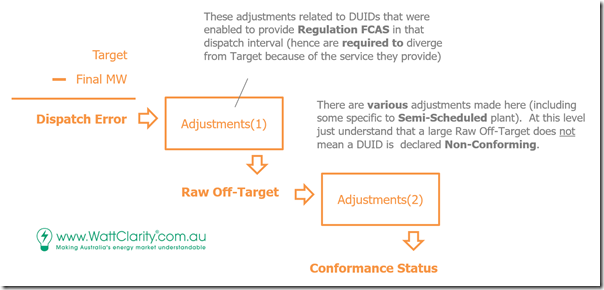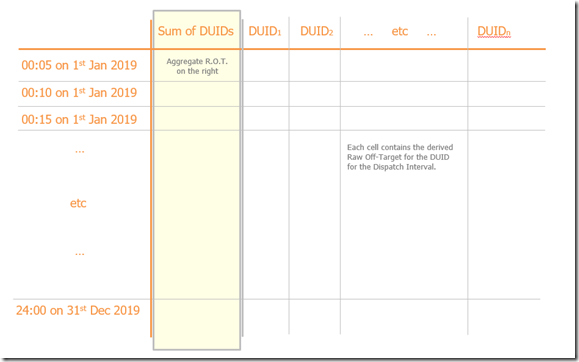For a number of years we’ve provided an explanation of the ‘Off-Target’ metric in this WattClarity Glossary Page.
The metric is calculated on an individual unit (i.e. DUID) basis for any Scheduled or Semi-Scheduled unit (it can’t be calculated for Non-Scheduled units because of the absence of a Dispatch Target from the AEMO).
However more recently we’ve realised the value of including this page here to clarify how this metric is calculated, and where it is used.
(A) Why is Off-Target important?
In dispatching the market, AEMO utilises the NEMDE mathematical model which allocates Targets to all dispatchable or partially dispatchable (supply-side and demand-side) units, based on how their bid/offers to consume or supply.
A principle of this model is that the numbers add up on both sides of the equation – in other words, the aggregation of all supply-side offers should always equal the aggregation of all the demand-side bids to consume (keeping in mind that AEMO is a defacto bidder for ‘bulk consumers’ who do not bid directly into the wholesale market). In broad terms, units are assumed to ramp linearly from their initial point at the start of the dispatch interval (e.g. ‘Initial MW’) to their Target for the end of the 5-minute dispatch interval.
Hence any deviation from any of the DUIDs will (all else being equal) result in frequency deviations away from 50Hz within that dispatch interval … and will require remedial action through means such as Regulation (and potentially Contingency) FCAS.
For this reason, it’s of value to keep a close eye on deviations away from Target … for an individual unit, but especially for groups of units.
(B) How to calculate Aggregate Raw Off-Target (AggROT)
In this article in May 2020 we presented this diagram to help explain how ‘Raw Off-Target’ is a metric that is derived by AEMO (we just gave it that name) en-route to operating their Conformance Status processes.
Please be clear that an extreme result for Raw Off-Target in one dispatch interval is not synonymous with being declared as ‘Non-Conforming’ by the AEMO (this is especially the case for Semi-Scheduled plant because of the general ‘Adjustments’ for all units – and some additional ones made for Semi-Scheduled units).
Also note that ‘Non-Conforming’ according to the AEMO is not exactly the same as ‘Non-Compliant‘ at the AER.
I also used this diagram to illustrate how to create a time-series of ‘aggregate Raw Off-Target’ for a particular group of DUIDs.
One key point is that this aggregation could be performed across any collection of units … or across all supply-side units (for instance).
(C) Where we have discussed Aggregate Raw Off-Target (AggROT)
In several of our analytical products (such as in Appendix 17 within GenInsights21) we have extended the concept of a unit-level Aggregate Raw Off-Target to different collections of units. In the GenInsights21 report, we analysed both:
1) Aggregate Raw Off-Target across the 48 coal units then remaining in service at the time of the report; and
2) Aggregate Raw Off-Target across all of the Semi-Scheduled (Wind and Large Solar) units operating in the NEM at the time.
On occasions we have written articles on WattClarity discussing Aggregate Raw-Off Target … and sometimes we have remembered to tag them with ‘AggROT’.



